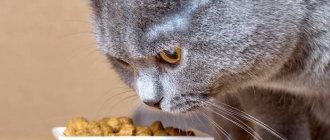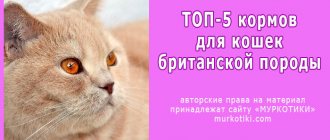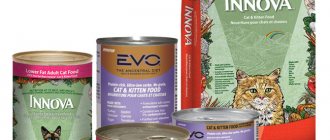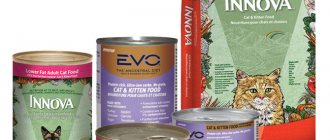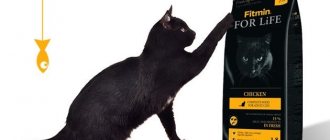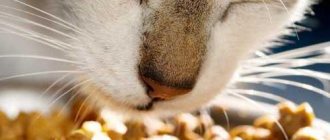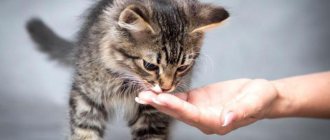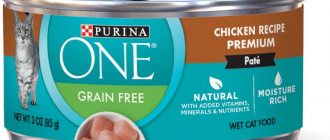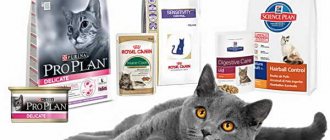For many specialists, as well as for dog and cat owners, the division of industrial food into classes is an immutable truth. They believe that since “super premium” is written on a package of food, this automatically guarantees decent quality ingredients, high digestibility and availability of nutrients, and if the word “holistic” is included in the description of the diet, then such a product is absolutely excellent in quality and composition, and is perfect for a pet.
Unfortunately, this is often only the perception of consumers, imposed by the competent actions of marketers, sales agents and “ambassadors” of a particular brand.
The principle of “divide and conquer”
The idea that some classes of food are better than others has firmly taken root in the minds of consumers, and we realized that it is high time to talk about what types of food there are, or rather, what the classification of animal food is in detail and frankly.
We would like to clarify some important points and help you avoid falling for the marketing scams of manufacturers and sellers.
The need to classify dry food arose among manufacturers of ready-made diets when the feed industry began to actively develop. New, more expensive diets appeared, and the question arose of how manufacturers could promote such foods and win the attention of consumers. After all, each manufacturer was not averse to presenting the advantages of their product as best as possible and highlighting the disadvantages of competitors.
Also, the classification of feed into classes is useful for large concerns that produce feed products in different price categories for different groups of consumers - this makes it easier for them to explain the differences between their many brands.
Feed classification is outside the law
You should know that there is no officially accepted industry or any other legal classification of feed quality. Accordingly, there are simply no officially established standards and requirements, confirmed by scientific research, that diets must meet in order to be classified in one or another of the classes.
Rather, the process goes, so to speak, in reverse - this market-imposed gradation of feeds forces interested parties to identify the key distinguishing features of each class in order to understand how the feeds differ.
The current classification can be called the joint “oral creativity” of producers, sellers and buyers. Everyone, at their own discretion and depending on their own benefits or interests, classifies ready-made food as they want.
Class boundaries cannot be determined
We are faced with the fact that a lot of information about the classification of feed available to a wide audience, especially on the Internet, looks reasonable and clear at first glance, but is essentially a figment of the imagination of supporters of one class or another.
You should not believe those who write that “super premium” feed uses the highest quality raw materials, and “economy” feed uses the worst. No matter how much one would like to believe it, everything is far from so simple. There are no clear gradations, for example, between “economy” and “premium”, “premium” and “superpremium”, “superpremium” and “ultrapremium” feeds.
Features, pros and cons
A cat's natural diet should consist of high-quality products prepared specifically for the animal. When preparing food, you should take into account the age category of the animal, characteristics and health status, as well as tastes in food. Creating the right diet is often difficult and time-consuming. That is why owners of tailed pets are increasingly turning to store-bought formulations.
The main advantage of industrial feed is its nutritional value and saturation of the body with all useful substances and vitamins. When feeding your cat a balanced diet, you should not worry about adding additional minerals and vitamins to its diet. All substances and useful elements are already in the feed. Depending on the class and type, cat products are intended for consumption by various animals.
There are also products aimed at treating diseases and preventing them. Meals with dietary meat (lamb, chicken and turkey) are designed for animals that lead a sedentary lifestyle and are prone to obesity. Products with fiber contribute to good metabolism and normalization of various organs.
Among the disadvantages, it is worth noting the low quality of the compositions of some manufacturers. Economy class food contains nothing else except flavor enhancers, additives of artificial origin, flavors and preservatives. The use of such products leads to many diseases and disorders in the body systems.
Also, when feeding, you should take into account the health status of the animal. Dry food contains almost no moisture. Therefore, for cats suffering from kidney and urinary system diseases, it is worth buying only specialized dry food, which has therapeutic and medicinal properties.
“Feed your pet correctly”: our classification of food
Since at the moment the spontaneous classification of feeds and their characteristics have become very firmly established among consumers, we decided to combine our own knowledge and experience in diet analytics, as well as data from foreign sources, and bring to your attention a summary table of the characteristic features of ready-made complete feeds with additional explanations of the features of each from classes.
Please note that we give all names of feed classes in quotation marks, since these are just names that are not terms.
Below are the characteristics of ready-made food for dogs and cats according to the “Feed Your Pet Correctly” version. You can determine what class of food you have on hand based on these criteria.
| Feed classes | ||||||
| Economy | Premium | Superpremium | Ultrapremium | Holistic superpremium | Biologically relevant | |
| Feed class in the name | ||||||
| The names are attractive, the emphasis is on taste! The words “delicious”, “appetizing”, “fragrant” are often used. | Names often contain information about the age or condition of the animal; less often they are informationally attractive. | The names are often more information-attractive and the emphasis is on the ingredients. | ||||
| Feed class on packaging | ||||||
| The packages are bright, they show photos of happy, cheerful animals. Photos of colored granules are often included. | The packaging is different, often bright and attractive. | The packaging is often bright, with images of purebred animals. | The packaging design usually uses a natural range of shades, but there are also bright, attractive photos of ingredients and views of nature. The animals themselves are sometimes depicted schematically. | |||
| Health icons on packaging | ||||||
| They are present very rarely and without details, all explanations are given in general terms. | Usually present, the packaging provides either general comments or detailed explanations of how the ingredients “work.” | |||||
| Features of feed formulas | ||||||
| Characterized by free formulas, the components in the composition may vary from batch to batch. | Fixed or conditionally free formulas are typical (they may contain ingredients named in groups, but not in such general terms as in “economy” feeds). | Characterized by fixed formulas, the ingredients cannot change depending on the prices of raw materials. | ||||
| Presence of ingredients named by groups | ||||||
| A lot of them. In the composition you can find “meat and offal”, “fish”, “cereals”, etc. | They do occur, but their proportion is different. If such ingredients exist, then the formula cannot be considered fixed. | No | ||||
| Features of ingredient No. 1 | ||||||
| Usually these are mixtures of different components. It is impossible to understand exactly what is contained in them. | Cereal, rarely a meat component. | Mostly meat component | ||||
| Availability of fresh meat and fish | ||||||
| No | Rarely, most often not | More often there is | Eat | |||
| Availability of useful supplements | ||||||
| No | Rarely, most often not | There are, for example, prebiotics, chondroprotectors, and substances for protecting teeth. | Many different additives, including phyto-components. | |||
| Presence of artificial colors and preservatives | ||||||
| Often | Rarely | More often than not | No | |||
| Presence of natural preservatives (tocopherols, rosemary) | ||||||
| No | More often there is | There are, or are used, other natural sources of antioxidants. | ||||
| Sales points | ||||||
| Tents, convenience stores, supermarkets, sometimes pet stores, online trading. | Large supermarkets, pet stores, online trading. | Specialized pet stores, veterinary clinics, rarely supermarkets, online trading. | Specialized pet stores, veterinary clinics, online trading. | Specialized pet stores, online trade. | Specialized pet stores, online trade. | |
Rating of cat food according to veterinarians
Since the quality of feed in general is very dependent on its cost, we will conditionally divide ready-made rations by price category.
Cheap feed
Let’s immediately clarify that we will take the price of the most common budget product as a guideline. The price of Whiskas dry food is 1100–1200 rubles. for 5 kg. The average cost of 1 kg is approximately 230–240 rubles. The rating includes the following brands:
- Advance. This is a premium food that contains both fresh and dehydrated meat. The former usually ranks high on the ingredient list. Dehydrated meat comes in either second or third place. Kitten food contains a higher percentage of animal ingredients. It contains a lot of grains, including maize, which often causes allergies, but the price-quality ratio is good. Large bags (15 kg) cost on average 4000–4200 rubles. The cost of 1 kg is approximately 260–280 rubles.
- Farmina (line of economy class food Fun Cat). The first place in the composition is occupied by meat flour, followed by several types of cereals. Additionally, in the list of ingredients you can find several more types of meat flour. The presence of common names, as well as the presence of wheat and corn, is confusing. The cost of large bags is 3600-3800 rubles, 1 kg - 180-190 rubles.
- Frank's ProGold. Some suppliers classify the food they produce as super premium, but in fact their quality is more likely to be premium. The first place in the composition is occupied by dehydrated meat, followed by several positions of cereals. Additionally, the list includes dehydrated fish, fish oil and powdered eggs. Large bags (7.5 kg) cost 2100–2200 rubles. The average cost of 1 kg is 280–290 rubles.
- Organix. Balanced premium dry food. Dehydrated meat comes first in the composition, followed by rice and maize. Additionally, the list includes barley kernels. Also present is fish meal, fish oil, brewer's yeast, cartilage and other preventive additives. The average cost of a large bag (18 kg) is 3700-3800 rubles, 1 kg - 200-210 rubles.
Average cost feed
In the rating of food in the mid-price segment, we will include products with an average cost of 300–500 rubles. for 1 kg when purchasing a large package. The list of brands includes the following brands:
- Gina Cat Rabbit & Rice. This is a dry complete food for adult cats. The first positions in the composition are occupied by chicken and rabbit meat. They are followed by barley, oats and rice. The food is unique in that it is a hypoallergenic diet. A large bag (18 kg) costs 5700–5800 rubles, the average cost of 1 kg is 320–340 rubles.
- Go! The line includes grain-free and low-grain foods. You can find preventive additives in the composition: cranberries, salmon oil, alfalfa, etc. The cost greatly depends on the type of food. The price of diets for cats without special needs is approximately 440–450 rubles. for 1 kg.
- Karmy. Premium food contains several types of meat and whole brown rice. These diets can be recommended for allergic cats. The manufacturer uses preventive additives: yucca Schidigera, probiotics, apples, etc. The average cost of 1 kg is 300 rubles.
- Summit. The main ingredient is dehydrated meat, but is followed by several plant-based ingredients: peas, rice, oatmeal and potatoes. The advantages include the absence of corn and wheat. In general, this is a good cheap super-premium food: on average, 1 kg costs 320–330 rubles.
Expensive feed
When compiling the list, we took into account feeds whose average cost exceeds 500 rubles. for 1 kg. The rating includes the following brands:
- Orijen. This is the elite among dry food: the meat content reaches 80–85%. The diet fully corresponds to the natural biological needs of cats. Unfortunately, the balanced composition can at the same time be considered a disadvantage: the product most often causes digestive upset in those animals that previously ate budget food. The average cost of 1 kg is 750–800 rubles, if you buy large bags.
- Acana. This brand of food contains less meat, so it is better suited for animals with individual digestive characteristics, and can act as a transition link. The average cost of 1 kg is 750–800 rubles.
- Grandorf. The food contains several types of meat. The list of ingredients in low-grain diets includes whole brown rice, which ranks 4–6. It extremely rarely causes allergies, but it also does not represent anything valuable. The line includes grain-free diets. As with other holistic products, the food is enriched with preventive additives. The average cost of 1 kg is 700–750 rubles.
Economy class
Unlike other classes, you will not find the word “economy” on bags of dog and cat food - it is not in the interests of manufacturers to place it there. The very name of this huge group of products suggests that they are designed for those buyers who are not very picky about the quality of diet for a dog or cat, do not go into details of the composition and want to save money.
Such diets are indeed cheaper than all other options for ready-made food, since they use far from the best raw materials. At the same time, the names of such products mostly try to convince buyers that the diets are very tasty and will appeal to their pets.
Formally, economy-class food contains all the nutrients an animal needs, and the data on protein and fat on the labels in the “Analysis” section meets the standards. These diets are considered balanced, as they contain all the necessary vitamin and mineral supplements.
How to understand that this is an “economy”
A characteristic feature of economy feeds are images of multi-colored granules on the packaging, but if there is no such picture, then this does not mean anything. The main feature of the compositions of this category of food is that almost all the ingredients in the list are indicated in broad groups.
This always indicates the lack of transparency of information about the composition and the fact that the quality of raw materials is not a priority for the manufacturers of these feeds. The formula, that is, the actual composition of the “economy feed” raw materials, can change from batch to batch, in accordance with fluctuations in the prices of the components, which is why it is called free, or non-fixed.
Pets are usually very willing to eat such diets, ask for supplements, and then may refuse higher-quality ready-made food, since the raw materials for such diets may contain various flavoring additives. Such foods are usually not divided by age (at best, there are two options - for kittens/puppies and for adult animals), breeds, or physical condition, but they are often divided by taste.
"Economy" - the most popular and advertised
Many large supermarkets now sell a variety of products, including ready-made animal food, which is produced under the name of the retail chain itself or under their own brand. Most of these ready-made feeds belong to the “economy” class.
It’s sad that it is “economy class” food that attracts buyers by the appearance of its packaging, and they are most often advertised on TV. It is not surprising that the advertising of these brands is truly professional, “tasty” and attractive - huge amounts of money are spent on it, the best agencies work on it. It touches the best feelings, and as a result, buyers automatically transfer the quality of advertising to the quality of the product.
The basic principles for assessing the quality of feed should be clear, clear and exclude any compromises or concessions. We strive to teach you to evaluate not advertising or attractive pictures on the package, but only the list of ingredients.
Economy products occupy a huge niche in the ready-made diet market, but unfortunately, we cannot recommend them as the best option for feeding pets.
Why are feeds divided into classes?
There is a generally accepted division into four price categories: economy, premium, super-premium and holistic. Sometimes ultra-premium is used to show the superiority of the product over others. There are certain standards that each class of food must meet.
Economy class feeds have a low meat content and are often replaced with vegetable proteins. The premium class contains 20-30% meat, but most feeds still contain millet or corn. Sometimes there is something worse, for example, harmful food additives or monosodium glutamate.
The highest quality class of feed is super-premium. The meat content in them reaches 60% and higher. Recently, a new class has appeared on the market - holistic, which includes the best products from the best.
Be careful when choosing food for your pet. Unscrupulous manufacturers often increase the bar for their product. What is written on the front of the package is not always the same as the contents. Read the ingredients, analyze, and only then make a choice. Also beware of fakes.
Premium class
It’s too early to rejoice if you see the inscription “premium quality” on the food label. You should not expect that “premium” ready-made food is as good in its own way as “luxury” high-quality premium brands of perfumes or clothing.
Premium food for dogs and cats has nothing to do with luxury or premium quality. In the finished feed market, this concept is greatly devalued. This is just a group of products that are CONDITIONALLY a little better and more expensive than “economy”, but worse than “super premium”.
The ingredients of “premium” diets are not so different from the composition of “economy class” products, but individual components of slightly better quality can be added to these feeds.
"Premium" ready-made foods are complete and balanced and, of course, are divided by taste, in addition to this they are usually divided by life stages and animal sizes. Sometimes among them there are products for animals with physiological conditions characteristic of dogs and cats - for example, intended for pets after castration and sterilization, or for those who are overweight.
Rating of the best manufacturers
Today the market is replete with well-known and not so famous manufacturers of food for domestic cats. The range of such delicacies is wide and varied. Let's look at a small rating of the best manufacturers producing high-quality and safe food for mustachioed pets.
Pro Plan
Our rating opens with an inexpensive but high-quality product for cats that belongs to the premium class. Pro Plan food comes in a wide range. You can choose food for both a kitten and an adult cat, as well as pets with specific diseases. Dry, wet and medicated food from this manufacturer is available for sale. It should be borne in mind that medicinal products can be given to pets only on the recommendations of veterinarians. The main positive qualities of these feeds are:
- perfectly balanced composition designed for individuals of different ages;
- highest quality;
- have a positive effect on the health of pets.
Brit Premium
This brand has been on the market for more than 20 years, but Brit Premium products appeared in Russian stores relatively recently, which is why many consumers treat such food with caution. This food is of high quality
During its production, all necessary standards are provided. Such foods are easily digestible without harming the gastrointestinal tract of cats. The main advantages of this product are:
- the highest quality of production - only natural meat is used;
- some time after taking this food, the cats’ fur becomes shiny, soft and silky;
- the pet becomes more active and energetic.
Royal Canin
These premium foods are produced not only for healthy individuals, but also for cats suffering from various diseases. You can easily find excellent food for elderly pets. There are products on sale that can satisfy the tastes of even the most demanding and capricious cats. Royal Canin treats contain all the necessary ingredients. The main advantages of such products are:
- a wide range of different feeds;
- acceptable price;
- perfect quality.
Hills
The products of this manufacturer collect a lot of positive reviews. They meet all the highest quality requirements. The product line also pleases with its diversity. Hills treats are sold in both dry, wet and canned varieties. Mostly there are universal treats on sale, but you can also choose options for pets suffering from stomach and intestinal diseases. The advantages of such feeds include:
- affordable price;
- large list of products;
- the presence of a large number of nutrients in the composition.
However, such foods contain a lot of carbohydrates and vegetable proteins. This must be taken into account. The rating of quality cat treats also includes products from such brands as:
- Sheba;
- Arden Grange;
- Bosh Sanabelle;
- Now Natural;
- Acana;
- Leonardo;
- Brit Care.
8 photos
“Gourmet” diets: taste or benefit?
Within the “economy” and “premium” options, we can distinguish “gourmet” or “gourmet diets” foods. Their name comes from the word “gourmet”, meaning the concepts of “gourmet” and “delicacy”. It is impossible to separate these foods into a separate class of diets, but it is worth talking about them, since the quality of the raw materials in them often does not at all correspond to the pompous names and laudatory statements from TV screens.
Such diets exist mainly in the form of canned food. There is a particularly large selection of similar products for cats. They benefit from their mouth-watering names and attractive food images on labels that appeal to the human perception of food.
Names are like menus
The names of “gourmet” diets often resemble dishes for people. They use the words "dinner", "roast", "stew" and the like. These foods are described very beautifully and attractively, almost like dishes in a good restaurant - with mention of sauces and gravies, simmering, stewing over low heat, the words “fragrant”, “tasty”, “tender”, diminutive names like “chicken”, “thighs”, or places or manufacturing technologies - “Catalan style”, “Oriental style”.
Usually their packages are small, for 1-2 meals, and their price is usually higher than the average cost of “economy” and “premium” food.
No matter how attractive the promises of these foods may be, we still urge you to pay attention to what is written in the fine print, namely, the actual composition of the products. Attractive labels and messages are designed to make owners salivate, but the ingredient list often falls short of high expectations.
There you can find the same general names for groups of components, including grains. Such vague components in no way correspond to the principles of haute cuisine or proper nutrition for cats and dogs.
Super premium class
“Super-premium” food is always divided not only according to taste, but also according to the size, age and physiological state of the animals. Sometimes this fragmentation intensifies, and food appears in the assortment intended for cats and dogs of different breeds - as a result, food lines “swell” to incredible sizes, and products of one brand can occupy 4-5 large shelves in a pet store.
Many of these brands have special lines of veterinary diets. The price of “super premium” class diets can vary greatly, but in general, they are significantly more expensive than “premium” foods. Some of these diets can be found on the shelves of large supermarkets, but more often they are sold in specialized pet stores and veterinary pharmacies.
The “super premium” level food is distinguished by the inclusion of special functional additives - for digestion, protection of joints, and the immune system. On the packaging you can find drawings and notes about the maintenance of various organs and systems of animals, the so-called “health claims” - “health statements”, indicating specific components or, so to speak, “in general terms”.
Preservatives in such foods can be either natural or synthetic, or a combination of one and the other.
The largest companies that produce “super premium” food traditionally distribute a lot of printed materials, conduct training for veterinarians and breeders, sponsor dog and cat shows, as well as veterinary conferences, carry out external and internal decoration for pet stores and veterinary clinics using their logos brands.
Smaller companies operating in the same segment strive to be like them, but they promote their products mainly via the Internet or through consultations at exhibitions.
Adviсe
To choose the right food for your pet, you can turn to professionals (breeders and veterinarians) or do it experimentally. You should buy food based on the animal’s age, weight, physical activity, health status, and breed.
“With the right choice of food, the animal will have a shiny coat and good condition. The food will be well digested, the pet’s stool will be well-formed and will not have a strong unpleasant odor,” explained animal engineer Anastasia Kalinina.
Attention to the composition!
Using the example of “super premium” diets, we would like to emphasize several very important points. The class of food is just a generally accepted perception of it, even if this class is written on the packaging in large letters. With the exception of the top category (“biologically appropriate diets”), the name of the food class says practically nothing about the quality of its raw materials.
Such different quality
In this regard, you should not think that all “super premium” diets are equally good or, conversely, equally bad. This broad class of food includes completely different brands and separate lines.
Among the “super premium” diets, there are brands that support the “natural” system of feeding dogs and cats with meat, and companies that add large quantities of grain to their diets, and those who, when describing ingredients, use general words (animal fat, poultry meal) .
The industry allows this, because it does not legally regulate the “class division” of finished feed. Therefore, a conclusion about the quality of each individual food and how well its base meets the needs of cats and dogs should be made only after a detailed study of the list of its composition.
Look beyond the first ingredient
Don't put a lot of emphasis on the #1 ingredient in a food unless the ingredient list says it makes up 75% or more of the total. In the comparative table, we showed that ingredient No. 1 may be different for different classes of food, but this in no way reflects the total share and variety of sources of animal and vegetable protein in the diet.
You should always evaluate at least the first five comprehensively and analyze the list of ingredients in order to figure out what predominates in the product - grain, that is, carbohydrates and vegetable proteins, or animal components, that is, animal proteins.
How to evaluate the quality of food based on its composition?
The composition is indicated on the label. We find it and read it. The ingredients are listed in descending order, that is, the very first ingredient is in the food the most, and the last one is the least amount.
Meat should always come first. The cat is a predator; the basis of its diet is meat. It must be specified what kind of meat it is and its content indicated as a percentage. If you see corn or wheat in the first place in the composition, remove such food away. Cereal-based food is not suitable for cats.
The remaining ingredients are listed below. Moreover, they must be indicated specifically and in detail. If you see a generalization, for example, it is simply written “by-products,” then, most likely, low-quality waste was used for production. A good food will specifically state what was used: liver, tripe, etc.
Keep in mind that corn is a cheap feed filler and is often an allergen. It is better to choose food that does not contain it, but contains rice, which is a high-quality ingredient and does not cause allergies.
Ultra-premium class
Previously, the gradation of feeds ended in the “super premium” class - these feeds were considered the best. But now, with the development of the industry, other classes of products have appeared that claim to be higher in quality raw material characteristics and much better suit the needs of dogs and cats as carnivores.
What is ultra-premium? Previously, such a variation of food did not exist at all; this class was recently invented by marketers when it was necessary to show that the composition of certain “super-premium” food was still better than that of competitors.
The group of “ultra-premium” products is quite small and practically no different from “super-premium” products.
Holistic super premium class
As you can see, we classify “holistic” products as the “super premium” class, since, in our opinion, they are quite similar. We see no point in separating these diets into a separate class. First, let's explain where this name came from.
Translated from Greek, the word “holos” means “full”, “whole”, “harmonious”. There is a philosophical movement that considers the relationship between the human body, his spirit and the surrounding world as a single whole and considers this the path to the harmonious existence and improvement of man.
The holistic approach to medicine seeks not to treat, but to prevent disease through a healthy overall lifestyle, including a balanced diet. In the food industry, this complex philosophy has been transformed into the idea that an animal's diet should contain elements from a variety of food groups, and this supposedly guarantees the health of the pet.
In the USA, the first “holistic foods” appeared back in 1974, and the fashion for them reached Russia relatively recently. The number of “holistic” brands is small compared to other “super premium” foods.
“Holistic diets,” depending on the brand, can either be divided into products for different age groups and physiological conditions, or produced as single products for cats or dogs of any age, but at the same time differ in taste and composition. Let's talk in more detail about the features of these feeds.
Not all “holistics” are created equal
Some consumers mistakenly consider foods labeled “holistic” to be elite products. Whatever properties are attributed to them - hypoallergenicity, organic quality, naturalness, environmental friendliness, and the ideal composition of the formula, which supposedly gives the animal everything it needs for health in the correct proportions, and is perfectly absorbed.
We would not recommend unconditionally believing all such statements, understanding that each pet is individual. We will soon release an article about the essence of various marketing statements on food packaging that manufacturers use to attract customers, follow our publications!
The price of a package of “holistic” food is considerable, and, as a rule, much higher than the cost of the average “super premium” diet.
Composition of typical “holistics”
If you look at “holistic diets,” most of them contain grain and good meat and fish ingredients, and in a variety of proportions.
Typical “holistic products” seem to be balancing on the brink: on the one hand, they share the idea that dogs and cats need quality animal protein, and on the other hand, they do not refuse to add grain to their products, citing the fact that the animal should receive a full range of different products, that is, meat, grains, vegetables and fruits.
To be honest, this position in the spirit of “both yours and ours” seems somewhat strange to us. We are against grains in ready-made diets for carnivores, especially for cats, and as for vegetables and fruits, their images often look beautiful on the packaging, while the proportions of these components in the composition are negligible.
In addition, it is strange to say that a dog and a cat cannot live without bananas, papaya and various exotic spices - these are necessary components of the diet of monkeys and the chef's cupboard, but they are in no way suitable for carnivores.
Class "Biological compliance"
The category of so-called “biologically appropriate” - biologically appropriate feed - appeared on the Russian pet market relatively recently. This class of food arose on the basis of a deep understanding that a cat is an obligate predator, and a dog’s DNA is 99.8% identical to the DNA of a wolf, therefore they should not eat food waste or grain.
Manufacturers of these diets try, in the industrial production of dry food, to imitate the composition of products that cats and dogs could receive while living in the wild.
Better quality raw materials
The main distinguishing feature of such food is its very high, about 70%, content of high-quality meat, poultry and fish, that is, sources of high-quality animal protein and fat.
In many of these feeds, grains are kept to a minimum (contained only due to the technological necessity of production) or even completely absent, and some of the necessary carbohydrates are supplied to the feed by legumes and potatoes. In the composition of these diets, one can also note the presence of fresh and raw meat and fish components.
If you evaluate the raw materials in such diets, then they are of much higher quality than in feeds of other classes, and what is important is that they are indicated clearly, in as much detail as possible (and not in general words and groups). Some “holistic” diets are somewhat similar to these products, but as a rule, there are significantly fewer meat ingredients.
Packaging designs for both “holistic” and “biologically appropriate” products often reflect nature motifs and subdued colors.
In general, we share this “natural” concept of nutrition for dogs and cats. True, as in “holistic” foods, “biologically appropriate” diets contain various herbs, vegetables, fruits and spices - we tend to consider them rather as an additional reason to talk about the product, since small amounts of these ingredients can serve only which are sources of fiber.
How to choose good cat food?
So how can you choose the right and nutritious food for cats and not fall into the trap of marketers?
There are quality standards, both Russian and American, so packaging labeling must comply with these standards. Be sure to read the composition of the food and the percentage of proteins, fats and carbohydrates in them. Do not take into account the characteristics written on the packaging - premium, super premium or holistic. The name means nothing; only its composition determines the value of the food
Premium class food must contain at least 20% meat, super premium food must not contain by-products, or there must be no more than 10%. Holistic foods are the most natural foods.
Remember that food for individual breeds is mostly a beautiful marketing ploy. However, for Persians, additional elements may be needed that allow them to remove hair, and for Maine Coons, their size should be taken into account - the food should be more nutritious and contain the highest possible percentage of meat. Food for kittens and pregnant cats should really contain more protein, so if this is your case, use the rating and choose the one that suits your wallet. But for older cats, it is better not to change the food if it suits her. For sterilized animals, you do not need to buy special food; it is enough to reduce its quantity by 10-15%. And if your kitty is very energetic, then you can increase the norm a little accordingly. Do not use medicated food unless recommended by a veterinarian. Specifics are the most important thing. Choose food that says “Chicken” instead of “Poultry,” and also give preference to those foods that say what part of the chicken was used in production. Cats are carnivores by nature and cannot live without animal protein. As a result, meat, fish, poultry must be in the required percentage. As a rule, these are premium and super-premium food. The best cat food option is one that contains fresh meat or dehydrated meat rather than meat powder. The fact is that feed manufacturers purchase raw materials of this kind from other suppliers, and if they contain preservatives, they are not indicated in the composition of the feed. It is also not worth mentioning that meat meal is often made from old, unhealthy or dying animals and birds. Sellers often exaggerate the value of grain-free food. Cereals in them are usually replaced by potatoes or legumes, which, in turn, are poorly digestible. However, they are good for cats with allergies to corn powder and wheat. Barley and oats are the most digestible, which is why the rating of such foods is higher. Grain protein (corn and wheat gluten) is digested better than whole grain based foods. And starches, by their nature, are an empty filler that is used in economy-class feed. Such food will not bring benefits to the cat. Synthetic dyes and flavors are not allowed in the finished mixture. Also, avoid giving preference to foods containing tomatoes, carrots or algae if your pet has a white or light-colored coat. As for preservatives, they should only be natural. These include vitamin A, E, C, and rosemary. If you decide to change food, do not immediately take a large package. Switch from old to new gradually. If any of the ingredients in dry food cause an allergy, you should definitely consult a doctor to prescribe proper nutrition.
Meet me by pack, see you off by raw material
Some people think that the higher the grade of food, the higher the quality of its protein sources and ingredients in general. In reality this is not the case. Even if you add the best quality rice and barley to the diet, this will not make the finished food better in terms of nutrition and benefits if it contains very little meat. After all, cats and dogs are carnivores, and it is important for them to receive high-quality animal proteins with their food.
Therefore, we believe that it is fundamentally important to study the entire composition as a whole, based on the quality and biological compliance of one or another component with the diet of carnivores, and first of all, try to evaluate what serves as the basis of the product - sources of plant proteins and carbohydrates (corn, rice, wheat, barley , potatoes, legumes) or still high-quality meat, fish and poultry - sources of animal proteins (chicken, lamb, rabbit, salmon, etc.).
What should the correct food consist of?
High-quality and good cat food should consist of meat, its composition should be at least 35%. Healthy sources of proteins should be chicken, rabbit, turkey, beef, and fish. The required protein content is at least 20%, which can be egg or milk protein. The content of high-quality by-products is allowed, but not more than 10%. For the normal functioning of the digestive tract of a pet, food must contain plant fiber. However, they should not exceed a quarter of the total composition. Wheat, rice, oats, and corn are used as plant fibers. You should not abuse these components to save on meat ingredients. Also, high-quality and healthy food contains vitamins and minerals.
Often in the composition of feed you can see the names of components that at first glance may seem harmful and unnecessary. However, this is not always the case. Far from harmful and even necessary additives may be hidden under names that are incomprehensible to us.
- copper and copper carbonate;
- cobalt;
- copper and iron sulfite;
- oxides of iron, copper, manganese and zinc;
- taurine;
- chloride or choline chloride.
Taurine is a useful nutritional supplement that increases the cat's activity and energy.
In addition, the category of safe additives includes ascorbic acid and calcium, as well as various vitamins (B5 B6 B1 B2, I15, B3, K, H, E C). If the chosen product contains such components, you can safely buy them, since they cannot negatively affect the health of your beloved pet. Food for cats of the highest class (the type and names are shown in the photo) will contain all the useful ingredients for them.
Arden Grange food is considered one of the best representatives of the super premium class.
Price issue
When choosing a diet for their pet, most people focus on the cost of a package of food, but it is more correct to estimate how many days a package will last, and then calculate the approximate cost of feeding per day. You will be interested to know that on average, this daily cost is not so different between quality meat-based diets and simple “premium” feeds.
It's all about feeding standards - for products rich in plant protein and carbohydrates, these standards are traditionally higher, while less “expensive” food is needed per day to satisfy the nutritional needs of the animal.
There are, of course, exceptions to the rules, but this is a general trend, so don’t be immediately alarmed by the price of a higher-quality product - in the end, the costs will not differ as much as it seems at first glance.

